The Soundscape of 2001: A Space Odyssey
2001: A Space Odyssey is known for many unusual choices in its direction. Among these are the iconic uses of music, most notably Thus Spake Zarathustra, and extended periods of time spent without any dialogue or even in total silence. Factoids on the use of sound are common on trivia pages about the film, but there is apparently no comprehensive overview of the soundscape available, except for this one. I hope it can be informative and interesting for anyone who comes across it.
The charts below summarize the soundscape of the movie 2001: A Space Odyssey and are organized according to which section of the movie, or the accompanying novel, they cover, and whether they include overlap in different types of sound according to the categories shown. Information on my methods and a link to the raw data as well as miscallaenous interesting points can be found past the charts.

 These charts both show the proportions of each type of sound in each part of the movie, not including overlap where there are multiple types of sound at once. The second includes a bar encompassing the entire movie for comparison, while the first has it left out for better readability. For an explanation of what not including overlap means, please see the methods section below!
These charts both show the proportions of each type of sound in each part of the movie, not including overlap where there are multiple types of sound at once. The second includes a bar encompassing the entire movie for comparison, while the first has it left out for better readability. For an explanation of what not including overlap means, please see the methods section below!
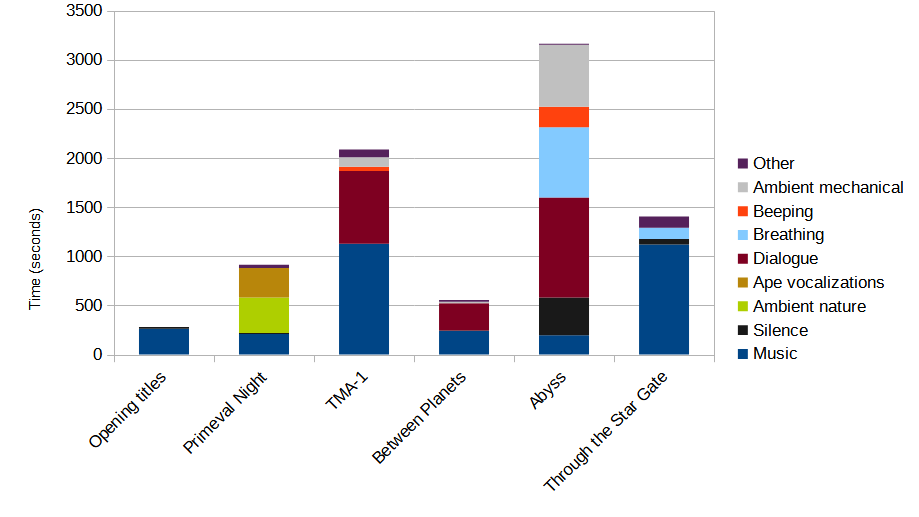
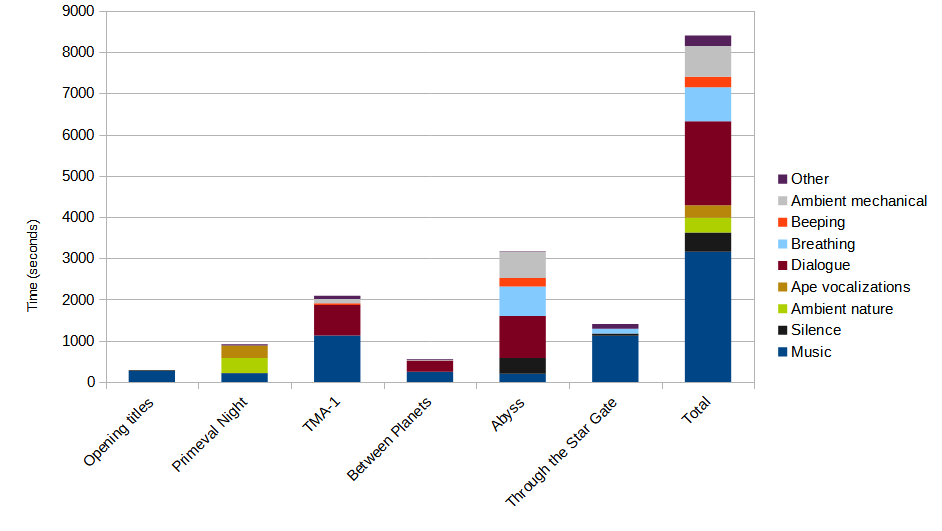 These charts both show the proportions of each type of sound in the movie according to the parts of the book, not including overlap where there are multiple types of sound at once. Like the previous pair, only the second includes a bar encompassing the entire movie.
These charts both show the proportions of each type of sound in the movie according to the parts of the book, not including overlap where there are multiple types of sound at once. Like the previous pair, only the second includes a bar encompassing the entire movie.
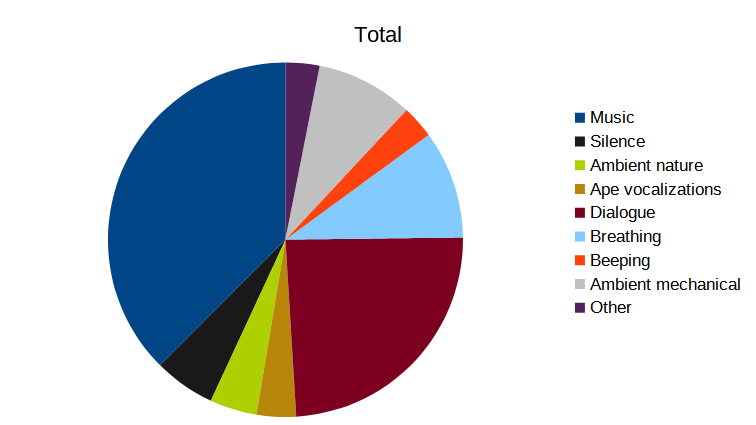
This pie chart is a different visualization for the data included in the "Total" bar seen in the previous charts. Below are pie charts for the rest of the sections in each chart; movie sections are on the left, book sections on the right. Note that the chart for the last section of both the book and the movie only appears once, as the data for these two are identical whichever system one chooses to use to split the story up.
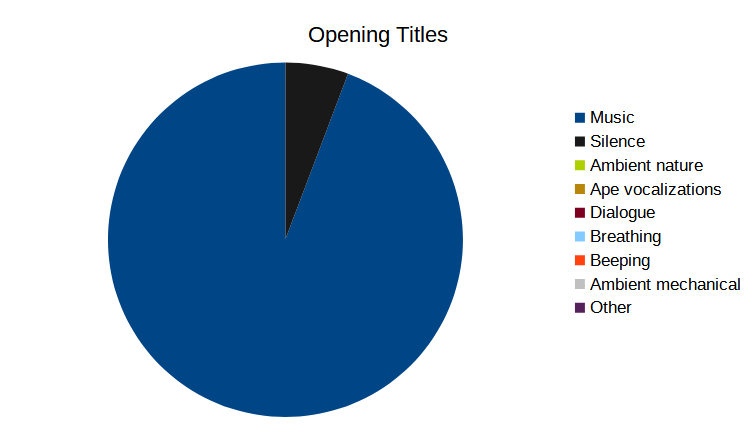
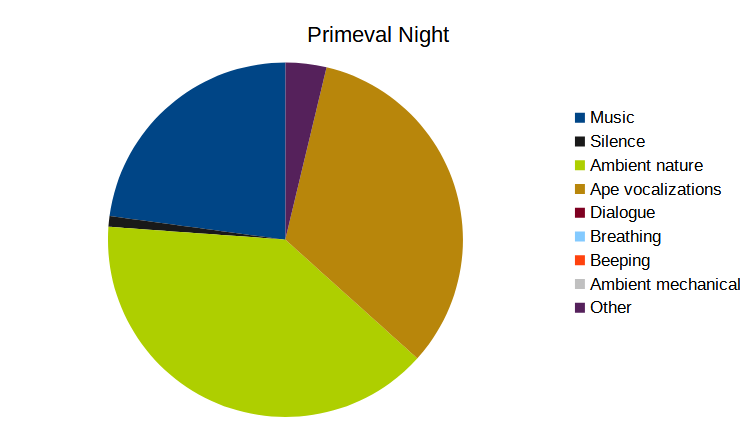
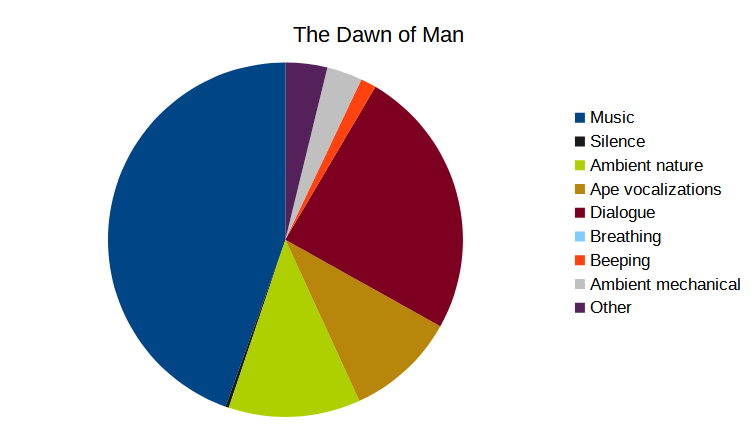
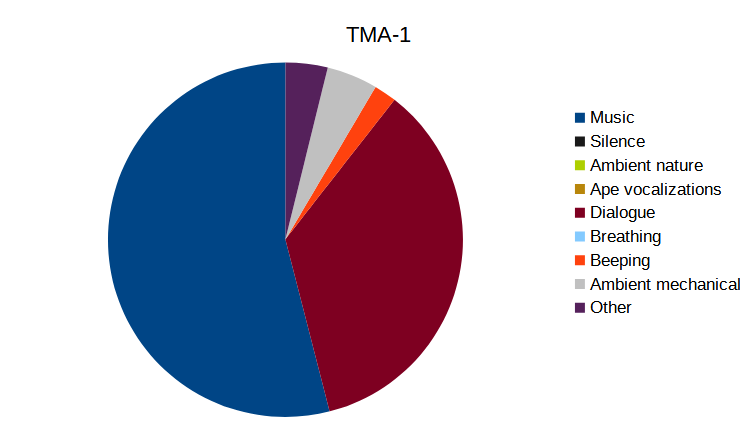
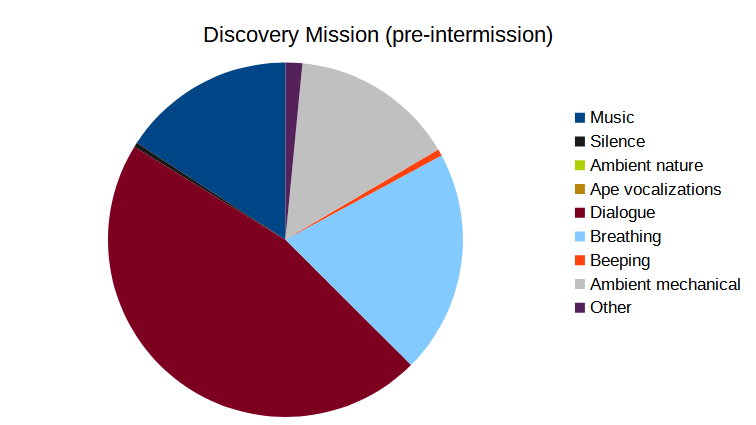
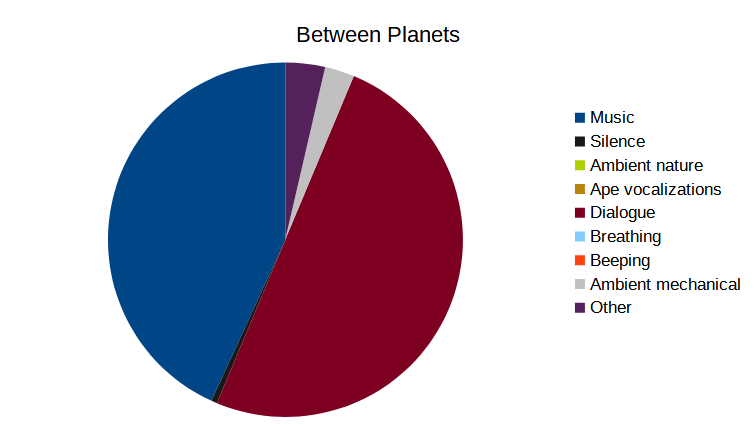
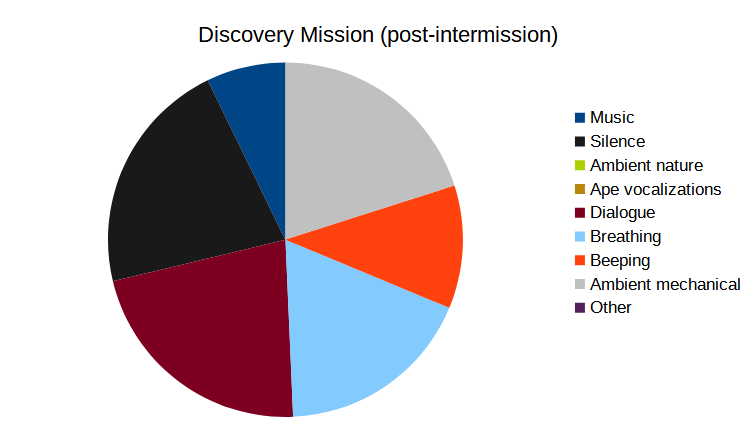
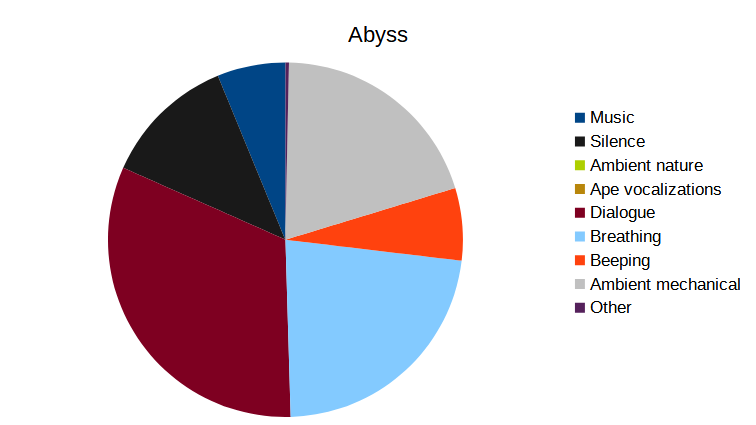
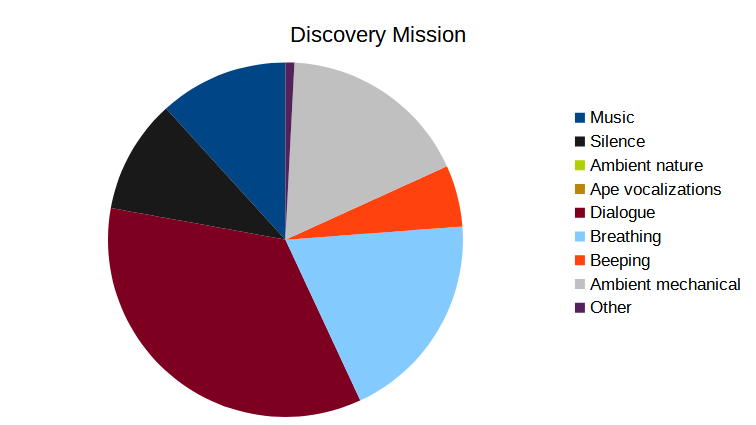
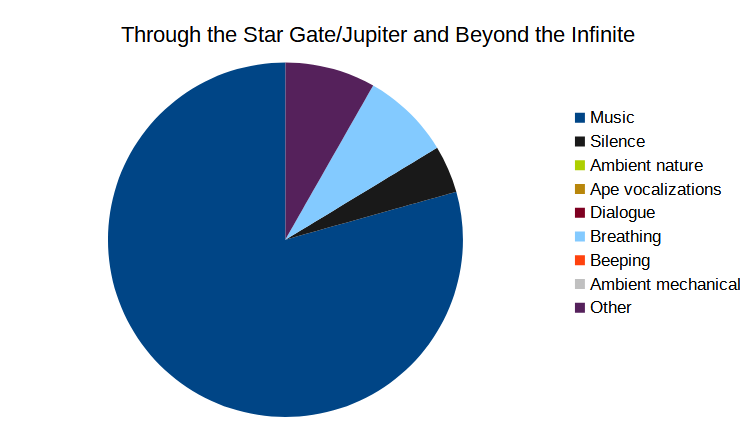
The charts below show the amount of each type of sound that falls within each section of the movie, including overlap when there are multiple types of sound at once. The first pair follow the movie sections, while the second pair follow the book sections. The second chart in each pair also shows the total amount of each type of sound for comparison.
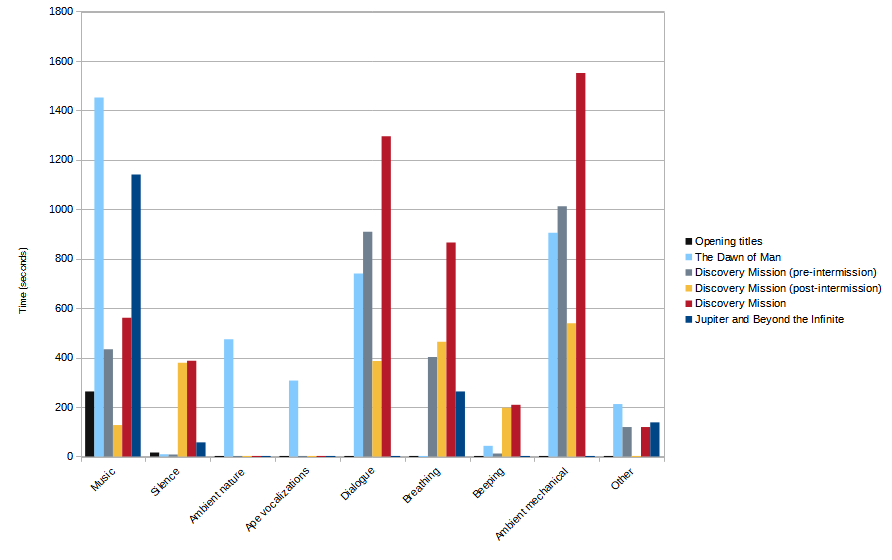
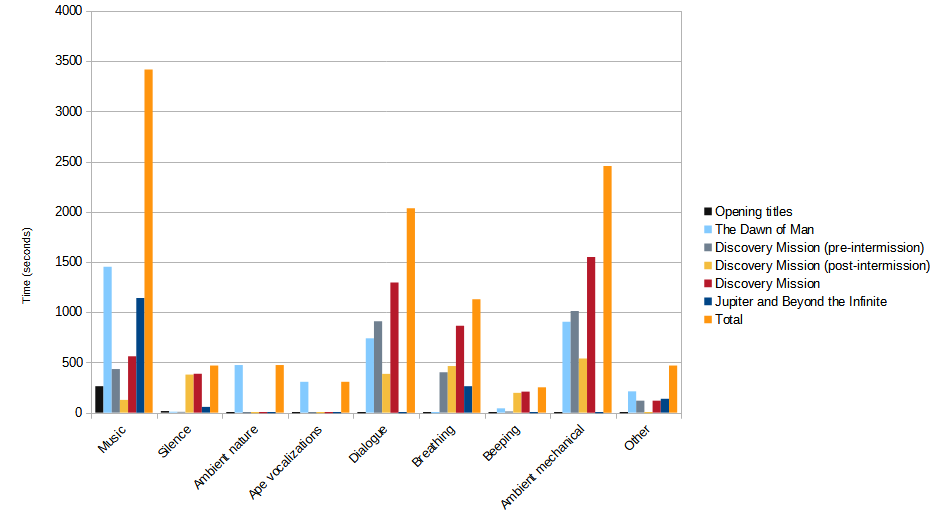
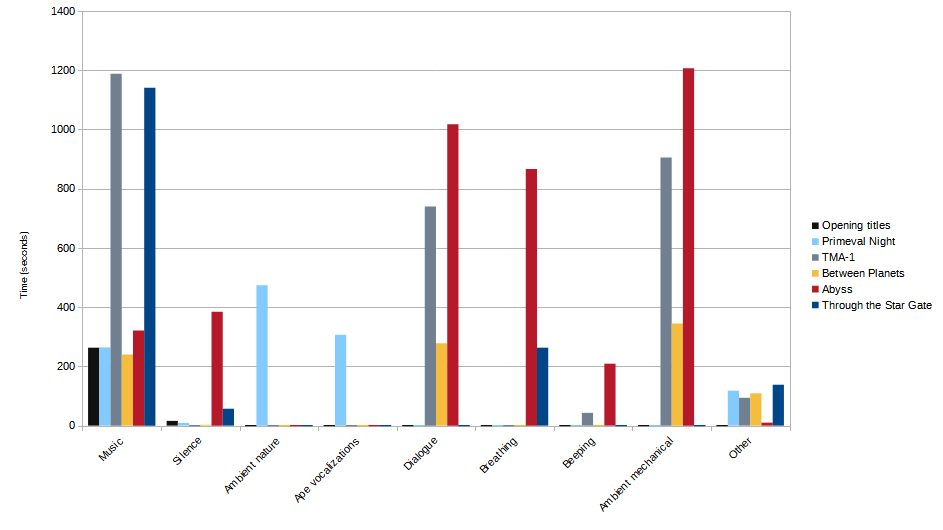
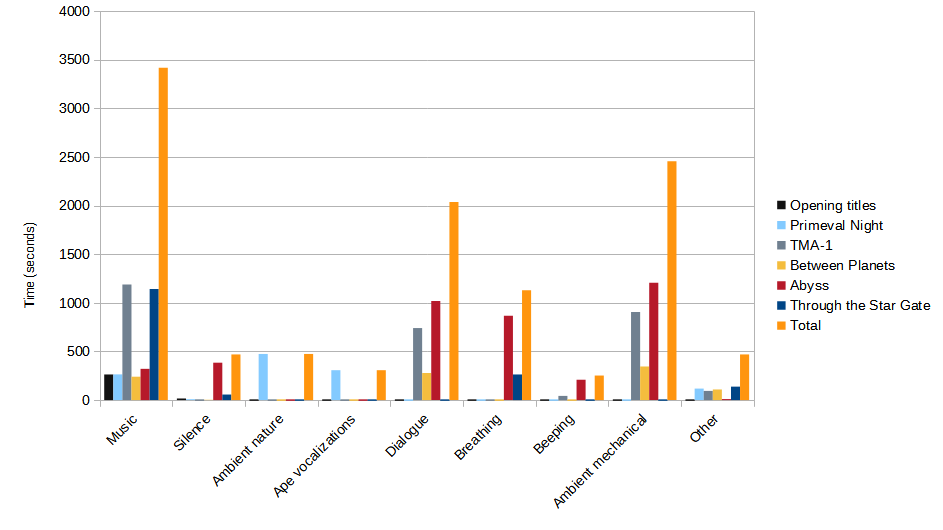
Methods
To arrive at these numbers, I went through the movie with the following method:
- The entire movie aside from the intermission and the closing credits was recorded as described below. The opening titles were recorded, but as seen above, are considered as a separate part of the movie.
- Any sound or change in sound (according to the categories below) lasting longer than about two seconds was recorded. Some exceptions were made based on context; for example, requests made to HAL by Bowman or Poole, such as “Rotate B Pod, HAL,” rarely exceed one second in duration, but were still counted towards dialogue. Conversely, during Primeval Night, there were some sections of ape vocalizations that exceeded two seconds, but were determined to be subtle enough to be counted as part of the background nature ambiance.
- All sound was sorted into one of eight categories: music, ambient nature (including wind, birds, and insects), ambient mechanical (including background white noise as well as doors opening, buttons being pressed, etc.), ape vocalizations, dialogue (including speech that did not take place in a two-way conversation, so not dialogue as such), breathing (and hissing of air), beeping, or silence.
- An ‘other’ category was also created, including sounds of movement, the leopard’s growling in Primeval Night, camera flashes and applause during the meeting at Clavius, the monolith signal, and the clinking of the white-haired Dave Bowman’s knife and fork in the hotel room.
- Because there was considerable overlap of different sounds, some had to be excluded to accurately represent the data in stacked bar and pie chart form. The hierarchy used for choosing only one predominant sound for each segment of time in which there was overlap is as following: dialogue and ape vocalizations dominate over beeping; beeping and ‘other’ dominate over breathing; breathing dominates over music; music dominates over ambient nature or mechanical noise. Thus, in the data used for the pie charts, there is only one second of sound featured per second of movie. The bar charts that appear after the pie charts do not follow this hierarchy and instead present the total amount of sound recorded in each category, regardless of overlap.
- For analysis purposes, the soundscape was split up both by the divisions in the movie itself and in the book. The divisions for the movie consist of the opening titles, The Dawn of Man (which covers everything from the first shot of the savannah to the end of the section on the Moon), the Discovery Mission pre-intermission, the Discovery Mission post-intermission, the Discovery Mission as a whole, and Jupiter and Beyond the Infinite. The divisions for the book consist of Primeval Night (the section involving the apes), TMA-1 (which covers everything from Heywood Floyd’s flight up to the space station to the end of the section on the Moon), Between Planets (which covers the Discovery mission up until Frank’s birthday), Abyss (which covers the Discovery mission from Frank’s birthday to Hal’s deactivation) and Through the Star Gate.
- The Discovery Mission section of the movie is separated in two due to a dramatic shift in tone and soundscape that occurs at the intermission, which can be observed by comparing the charts for the two divisions and the complete Discovery Mission section. The section The Moons Of Jupiter is not included in the book divisions here because the movie does not include the events from that section of the novel.
Trivia
Some interesting features that may not be apparent from the charts above:
- This analysis was begun after I noticed that various articles about the 2001 film stated that the film contained only 40 minutes of dialogue; among them, The Guardian , Vox, Hollywood Reporter, and many more, as a Google search for ‘2001 a space odyssey “40 minutes of dialogue”’ yields over 3,000 results. The earliest instance of this statistic I found on the Internet, and presumably the source for the rest (as none I saw actually included citations) appears to be a Criterion article. Even then, no explanation is provided for how the number 40 was arrived at, and whatever its origin, it appears to actually be an overestimate, as I recorded only 2035 seconds, or 33 minutes and 55 seconds, of dialogue in the entire movie. Personally, I suspect it may be counting the number of minutes in the movie that contain dialogue, rather than the true amount of time spent on it.
- Strauss’s The Blue Danube is heard only in TMA-1, and Kachaturian’s Adagio is heard only in Between Planets/the pre-intermission portion of the Discovery mission.
- Although there are 278 seconds of dialogue listed for Between Planets, all of this is contained within the recorded interview shown featuring the Discovery’s crew; there is no ‘real-time’ dialogue in this part of the movie.
- When Bowman leaves the Discovery to retrieve Poole’s body, the scene switches frequently between an interior view of Bowman in the pod and Poole’s body; with it, the sound switches between mechanical ambiance or beeping in the pod to silence in the vacuum of space. These transitions occur every 15.05 seconds on average, with the pod sounds lasting an average of 14.7 seconds and the silent sections lasting an average of 15.4 seconds; excluding one outlier of 65 seconds in the pod, the overall average becomes 12.3 seconds and the average for the pod sounds becomes 9.1 seconds.
- After twice requesting entry to the Pod Bay, Bowman repeats “Do you read me, HAL?” (or “HAL, do you read me?”) seven times before HAL gives in and responds to him.
- It takes HAL nearly a full minute (54 seconds, to be exact) to sing the chorus of Daisy Bell as he’s being deactivated.
- The white-haired version of Bowman in the hotel room is apparently alerted to the presence of both his bespacesuited past self and aged future self by the sound of their breathing.
You’re free to use any of this information in your own project with attribution as per the Creative Commons license below! If you’d like me to see what you’re using it for, or know about other aspects of the sound in this movie you think I should’ve included, you can contact me via my site profile page. The raw data is available here if needed.